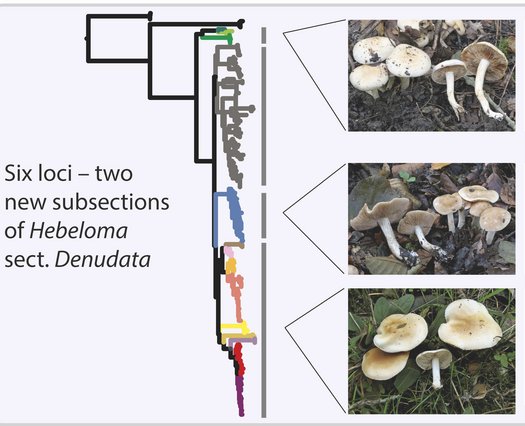Research Interests
Species delimitation, systematics, phylogeny and distribution of ectomycorrhizal fungi
Mycology, EU-Project "BioDivMon: Monitoring and mapping of fungal diversity for nature conservation (FunDive)"
Species delimitation, systematics, phylogeny and distribution of ectomycorrhizal fungi

Most people feel familiar with the term fungi, but compared to other organisms fungi are still much neglected in nature conservation and ecological research. This paradox is partly the result of the mostly secretive lifestyle of many fungal species hidden in the soil, as microscopic films on rocks, on or within the bodies of other organisms. An additional challenge is the difficulty to figure out the true diversity of fungi, because not all species have visible morphological characters which would distinguish them from look-alikes. For some fungal groups it is not uncommon that the genetic diversity exceeds by far the diversity of the morphologically recognizable "units". Among the fungi there are particularly high numbers of so-called "cryptic species, taxa which cannot be distinguished except for their genetic setup.
Within FunDive, an initiative funded by the Biodiversa+- project of the European Commission researchers from 26 institutions in 18 countries work together with the aim to tackle these challenges and to put fungi biodiversity on the map to enhance European conservation efforts.
Citizen Scientist can play an important role in this project, see below for current activities:
https://fun-dive.eu/get-involved/

Dr. Ursula Eberhardt
Hebeloma is a genus of mushrooms; one of its members is the poison-pie mushroom. Members of the genus form ectomycorrhizal symbioses with plants, predominantly woody plants such as forest trees, but some also alpine dwarf shrubs. The group has a mostly northern hemispheric distribution. The aim of the project is to investigate species limits and the infra- and intergeneric relationships of the genus Hebeloma and some close relatives, using molecular and morphological methods. Till 2016 we mainly worked on Hebeloma in Europe – the results were summarized in a number of scientific publications and in volume 14 “Hebeloma (Fr.) P. Kumm.” of the series Fungi Europaei. Now we are investigating Hebeloma species of other continents, especially of North America. Our project is supported by local collectors supplying material.
Collaborators: Prof. Henry J. Beker (Royal Holloway College, University of London, Plantentuin Meise, Belgium), Mr Peter Bartlett (Surrey, U.K.), Ms Caroline Hobart (British Mycological Society) and until 2021 Dr. Nicole Schütz

Dr. Ursula Eberhardt (principle investigator subproject), Cornelia Krause (2016–2017), Christina Schüßler (2017–2018)
The aim of the GBOL project is to DNA-barcode the species diversity of Germany. This subproject is dedicated to larger fungi, in particular those dwelling in forests. Our goal is to utilize existing knowledge and collections, for example museum collections, collections of citizen scientists or other scientific projects (i.e. WiNat – Wildnis Naturerbe) for filling gaps in public sequence databases for species identification, such as UNITE oder BOLD, in order to enhance the knowledge of the German funga. We are supported by other herbaria such as the Senckenberg Museum für Naturkunde Görlitz, the Staatliches Museum für Naturkunde in Karlsruhe und the Botanische Staatssammlung München. The DNA extracts generated in this project are being integrated in the DNA collection of the Naturkundemuseum Stuttgart. The project is supported by the Bundesministerium für Bildung und Forschung (BMBF) as research for sustainable development (FONA, reference no. 01 LI 1501I).
Collaborators: Prof. Dominik Begerow (principal investigator GBOL fungi; Ruhr-Universität Bochum), Dr Ben Bubner (Thünen-Institut für Waldgenetik, Waldsieversdorf), Dr Ulrike Damm (Senckenberg Museum für Naturkunde Görlitz), Prof. Gerhard Rambold (Universität Bayreuth), Dr Markus Scholler (Staatliches Museum für Naturkunde Karlsruhe) und Prof. Marc Stadler (Helmholtz Zentrum für Infektionsforschung Braunschweig)